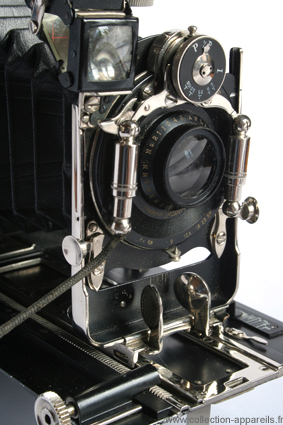|
Ernemann Heag XVI |
Manufactured or assembled in Germany from 1909 to (Circa) 1918.
Index of rarity in France: Infrequent (among non-specialized garage sales)
Inventory number: 2456
See the complete technical specifications
Chronology of cameras Ernemann
The Ernemann Heag XVI, produced from 1909 to 1918, represents Ernemann's contribution to the intriguing but limited family of early 20th-century combined cameras, which were both true plate cameras and genuine folding cameras in a single camera.
The first combined cameras appeared in the USA starting in 1902 with companies like Manhattan Optical Co and Blair, followed by a few others including Kodak. In Europe, a few manufacturers followed suit: Wuensche for Girard's "Le Rêve" and the Nixe-Universal (1904), Nettel (Duplak 1911), and Ernemann with the Heag XVI. However, the ingenious concept of combined cameras did not enjoy long-lasting success, about a decade in America and a couple more in Europe. This difference in duration can likely be explained by the more extended use of glass plates on this side of the Atlantic. The decline of the combined camera formula can also be attributed to the progress in the quality of films and print paper. The fine detail achieved in photos on film was gradually approaching the results obtained with glass plates.
The Heag XVI, benefiting from Ernemann's excellent craftsmanship, consists of two parts: the actual camera, which can be used with 9 x 12 plates, and a removable back containing a No. 101 film, yielding images of 8.5 x 11.5 cm.
A black metal shutter, measuring 10 x 12 cm, is inserted into the back for film, allowing the sensitive surface to remain in the dark when separating the back and the camera. This makes it possible to take photos on plates between shots on film. A small black screen with an articulated ring is provided to maintain darkness over the film when the black shutter is removed for taking pictures on film. It is of the same width as the shutter and fits into the same slot but only penetrates about one and a half centimeters.
A distinctive feature of this camera is that the film and plates are at the same distance from the lens, which is generally not the case with other combined cameras that require the use of two different focus scales, one for plates and another for film.
The Heag XVI is of double extension, with an Ernemann shutter at 1/100 with pneumatic brake and a cable release, and an Ernemann Aplanat Symmetrical lens. It has both horizontal and vertical adjustments. It includes a clear viewfinder with a bubble level, two inactinic (non-light-sensitive) viewing ports on the back, and two tripod sockets with the standard Congress thread pitch to complete the equipment.
This camera is a Heag XVI. It differs by some points (Lens board, engraved distances plate) from the camera presented here.


Interesting links or bibliography :
Add a link or element of bibliography, a picture taken with this camera, a picture of box or an ads about this camera
Your photos taken with the same camera:
Cameras from Ebay France (Ernemann) (Uploaded each 3 hours)
 appareil photo ancien à soufflet ernemann dresden 41,50 euros / 17 enchères Finira le 06-05-2024 à 17:17:25 |








